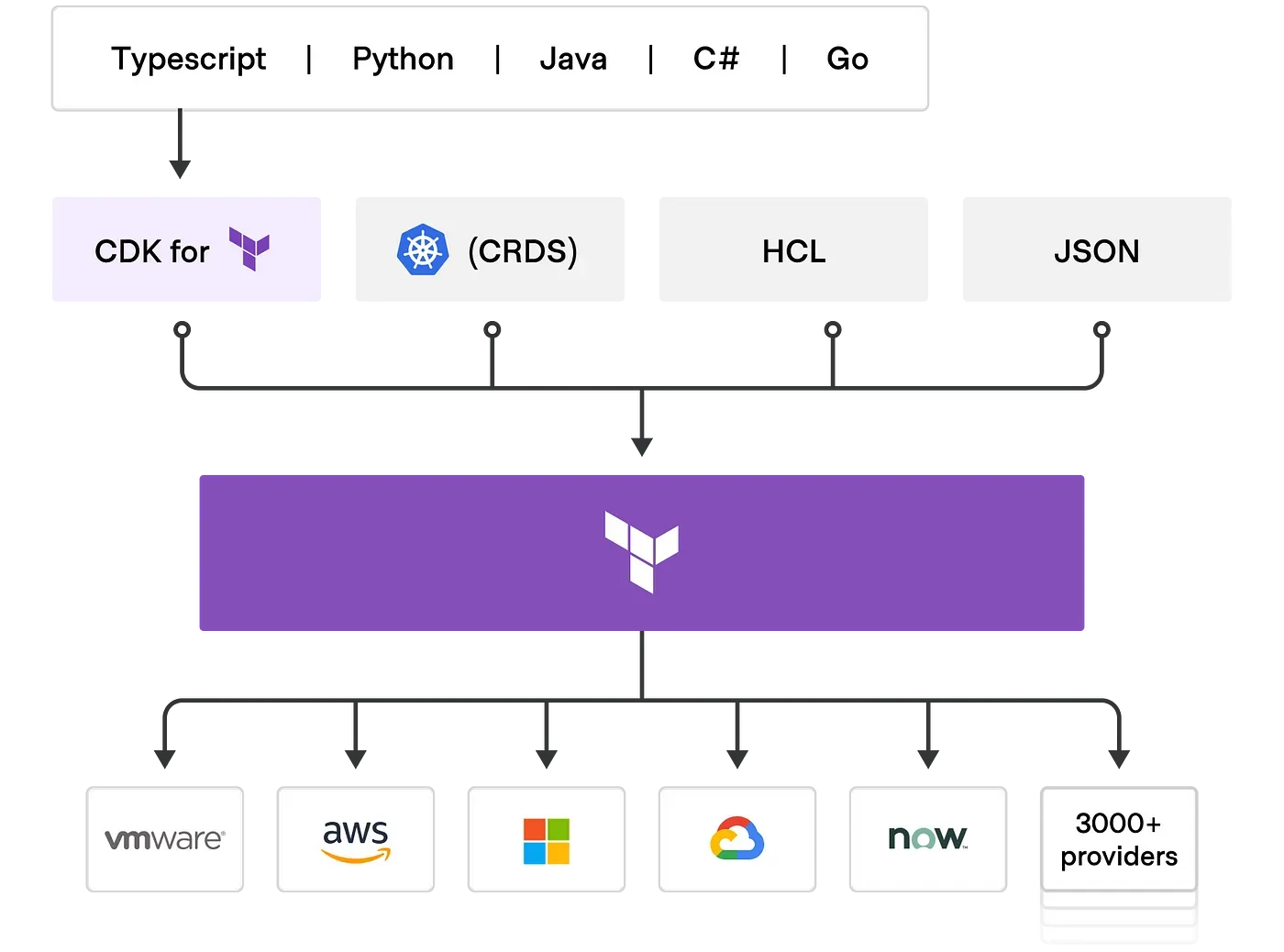Introduction
In this blog I will explain what is Terraform and some of its common terms. I will also list some good to follow standards when you start using Terraform.

Table of contents
Open Table of contents
What is it?
- Terraform is an infrastructure as code tool that lets you define both cloud and on-premise resources in human-readable configuration files.
- It can manage both low-level(Networking, Storage) & high-level components(DNS, SaaS).
- It can be used to manage single application and also an entire datacenter.
What it isn’t?
It is not a configuration management tool that focuses on single application configuration but Terraform focuses on higher-level abstraction like managing the entire environment.
Terraform Editions
Open Source
A free to download tool that you interact with CLI.
Terraform Cloud
- SaaS application that runs in a secure remote environment and stores states and secrets.
- Connects to VCS and new commits triggers Terraform automatically.
- It has Rich UI and RBAC controls.
Terraform Enterprise
Self-hosted distribution of Terraform Cloud. It offers enterprises a private instance of the Terraform Cloud application, with no resource limits and with additional enterprise-grade architectural features like audit logging and SAML single sign-on.
Terraform Jargons
Workspace
- A workspace contains everything that Terraform needs to manage a given collection of infrastructure.
- It links to VCS and has Variables, Credentials, Secrets, State versions, and Run History.
Backend
A backend defines where Terraform stores its state data files.
terraform {
cloud {
organization = "sampleorg"
workspaces {
name = "dev-workspace"
}
}
}
Provider
- Provides abstraction to APIs that connect to the infrastructure hosts.
- Without providers, Terraform can’t manage any kind of infrastructure.
- Every provider makes a list of resources and data types available for use in the Terraform code.
Registry
The Terraform Registry is an interactive resource for discovering a wide selection of integrations (providers), configuration packages (modules), and security rules (policies) for use with Terraform.
HCL
HCL(HashiCorp Configuration Language) is a declarative and domain-specific language.
State
- Terraform is a stateful application, meaning it keeps track of everything it builds in the infrastructure.
- State is used by Terraform to map real-world resources to your configuration.
How Terraform works?
- Terraform creates and manages resources on cloud platforms and other services through their APIs.
- Providers enable Terraform to work with virtually any platform or service with an accessible API.
- The core Terraform workflow consists of three stages:
Write
Defining resources
Plan
An execution plan that describes the infra terraform will create/update/destroy based on existing infra and your configurations.
Apply
Performing the operations in the correct order by respecting resource dependencies. Can be automatic or manual.
Configuration Language
Terraform supports HCL, JSON, CRDS and CDK. CDK allows you to use familiar programming languages to define and provision infrastructure. It also lets you leverage the power of your existing toolchain for testing, dependency management, etc. In this blog we will focus on HCL and how to configure Providers, Resources and Modules.

HCL
Provider
Terraform Cloud and Terraform Enterprise install providers as part of every run.
Provider configuration
Provider configurations belong in the root module of a Terraform configuration. Child modules receive their provider configurations from the root module.
provider "aws" {
alias = "us_east_1"
region = "us-east-1"
}
Provider Requirements
Each Terraform module must declare which providers it requires, so that Terraform can install and use them.
terraform {
required_providers {
mycloud = {
source = "mycorp/mycloud"
version = "~> 1.0"
}
}
}
Variables, Outputs, and Locals
In comparison with traditional programming languages,
- Input variables are like function arguments.
- Output values are like function return values.
- Local values are like a function’s temporary local variables.
variable "image_id" {
type = string
}
output "instance_ip_addr" {
value = aws_instance.server.private_ip
}
locals {
common_tags = {
Stack = local.stack
Environment = local.environment
}
}
Resource
Each resource block describes one or more infrastructure objects, such as virtual networks, compute instances, or higher-level components such as DNS records.
resource "aws_athena_workgroup" "default" {
name = "default"
tags = locals.common_tags
configuration {
enforce_workgroup_configuration = true
publish_cloudwatch_metrics_enabled = true
result_configuration {
output_location = "s3://some-bucket/path"
encryption_configuration {
encryption_option = "SSE_S3"
}
}
}
}
Data Sources
Data sources allow Terraform to use information defined outside of Terraform.
data "aws_vpc" "default" {
id = "vpc-0aexzk638sp5h9u7v"
}
Modules
Containers for multiple resources that are used together.
Root Module
Every Terraform configuration has at least one module, known as its root module, which consists of the resources defined in the .tf files in the main working directory.
Child Modules
A module that has been called by another module is often referred to as a child module.
Published Modules
In addition to modules from the local filesystem, Terraform can load modules from a public or private registry. You can find some of my AWS Terraform modules here.
module "example_glue_job" {
source = "github.com/komminarlabs/terraform-aws-glue-job?ref=v0.1.0"
name = "example-glue-job"
max_retries = 1
number_of_workers = 2
schedule = "cron(0 12 * * ? *)"
script_location = "S3://example-bucket/location/script.py"
trigger_type = "SCHEDULED"
worker_type = "Standard"
default_arguments = {
"--VAR1" = "some value"
}
tags = {
Environment = "development"
Stack = "glue"
}
}
Standards
- Use
countonly for enabling/disabling resource creation and use for_each for loops. - Variables are ordered A-Z, but tags always comes at last.
- Multi-line list or map should be in new line.
resource "aws_sagemaker_domain" "default" {
domain_name = var.name
app_network_access_type = var.app_network_access_type
auth_mode = "IAM"
subnet_ids = var.subnet_ids
vpc_id = var.vpc_id
tags = var.tags
default_user_settings {
execution_role = var.role_arn != null ? var.role_arn : aws_iam_role.default[0].arn
security_groups = var.security_groups
jupyter_server_app_settings {
lifecycle_config_arns = [aws_sagemaker_studio_lifecycle_config.jupyter.arn]
default_resource_spec {
instance_type = "system"
lifecycle_config_arn = aws_sagemaker_studio_lifecycle_config.jupyter.arn
}
}
kernel_gateway_app_settings {
lifecycle_config_arns = [aws_sagemaker_studio_lifecycle_config.kernel.arn]
default_resource_spec {
instance_type = "system"
lifecycle_config_arn = aws_sagemaker_studio_lifecycle_config.kernel.arn
}
}
}
}
- There are some linters already available for you to use